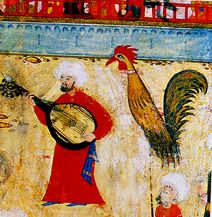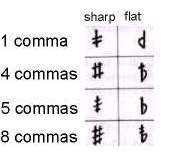|

title unknown (detail)
What is a makam?
Oransay described makam (Turkish
makam, plural makamlar; Arabic maqam, plural
maqamat) as 'composition rules'. They are definite scales which are
governed by certain rules which we will talk about later. A makam
has no intrinsic (allegorical) value and is not bound to certain times of
the day or year, as is the related Indian raga. The makam names
designate an important note in the scale (i.e.
Turkish
Cargah, Arabic
Chahargah: fourth position), or a city
(i.e. Esfahan, it is
sometimes spelled as Isfahan), a landscape (i.e. Turkish
Hicaz, Arabic Hijazi), a person (i.e. Kurdi) or a
poetic abstraction (i.e. Suzidil: heart
glimmer).
Makam principally distinguishes the eastern classical
tradition from western musical practice. Based on the use of untempered
intervals (with as many as 53 microtones amplifying the western octave), a
given makam follows a particular scale and a set of associated
musical practices. Each makam joins a tetrachord (Turkish
dortlu), and
a pentachord (Turkish besli). Certain rules/characteristics of a
makam may include the entry tone (Turkish giris, Arabic
mabda), the final tone (Turkish karar, Arabic qarar)
which may or may not be the same tone as the entry tone, the leading tone
(Turkish yeden), dominant (Turkish guclu) and tonic (Turkish
durak), as well as stressed secondary tonal centers. The
seyir (path, way) (Arabic zahir) of a makam is
determined by the direction of the melody, which may be either ascending
(Turkish cikici) or descending (Turkish
inici) or a
combination of the two (Turkish inici-cikici).
Range (makam may be extended above and below the octave without
repeating), modulation, temperament, melody types, and cadential endings
(i.e. suspended cadences) may also determine a makam's make-up.
Compound makamlar
exist which combine elements from two
makamlar. Thousands of makamlar have been theoretically
conceived though only a few hundred have been used. Of these, about one
hundred have been fully developed into musical
settings.
The
computation of the exact sizes of the microtones and the notation of
makam are rather complicated, and several alternatives were
presented at the Cairo Congress on Arab Music in 1932. Some of the scale
systems discussed at this meeting were obtained through mathematical
computation and some were established experimentally. The most important
systems were those presented by representatives of the Royal Institute of
Arabian Music in Cairo, by Idris Ragib Bey and I. Shalfun of Egypt, by
Xavier Maurice Collangettes of the University of St. Joseph in Beirut, the
Turkish system of Rauf Yekta Bey from the Conservatory of Turkish Music,
and the system of Shaykh Ali al-Darwish (student of Rauf Yekta Bey). The
differences between theorists and musicians, as well as modern research on
the tonal structure of vocal and instrumental music indicate that none of
these systems provides an accurate description of actual musical practice.
They are merely convenient tools for prescriptive and didactic purposes.
Conservatories, musicians and theorists in different countries use
different scale systems which leads to the differences in the notations of
accidentals and makam names.
It is
impossible for us to explain all the different systems or makamlar.
In the "Music" section of this web-site, there are a few pieces by famous
Turkish composers. Because of our Turkish musical background and to
understand the accidentals and the pieces better we would like to say a
few words about the Arel-Ezgi system. In Turkey, Rauf Yekta Bey's work was
continued by Subhi Ezgi and Sadettin Arel. The system they came up with,
later know as the Arel-Ezgi system, is the most widely practised system
currently. The Arel-Ezgi system consists of a theory of intervals,
involving such discrete intervals as the koma (comma). Every whole
step is divided into 9 commas and accidental markings indicate raising or
lowering the pitch by 1, 4, 5, 8, and 9 (which is the double sharp/flat)
commas:

Reprinted from:
Kurt Reinhard: The
New Grove: Dictionary of Music and
Musicians. vol.
19. ed. London: Macmillan, 1980
Josef Pacholczyk: The
New Grove: Dictionary of Music and
Musicians. vol.
1. ed. London: Macmillan, 1980
Karl Signell: Makam: Modern
Practice
in Turkish Art Music. New
York: DaCapo Press, 1985
Walter Feldman: Music of the Ottoman
Court. Berlin: GAM- Media GmbH, 1996
|

